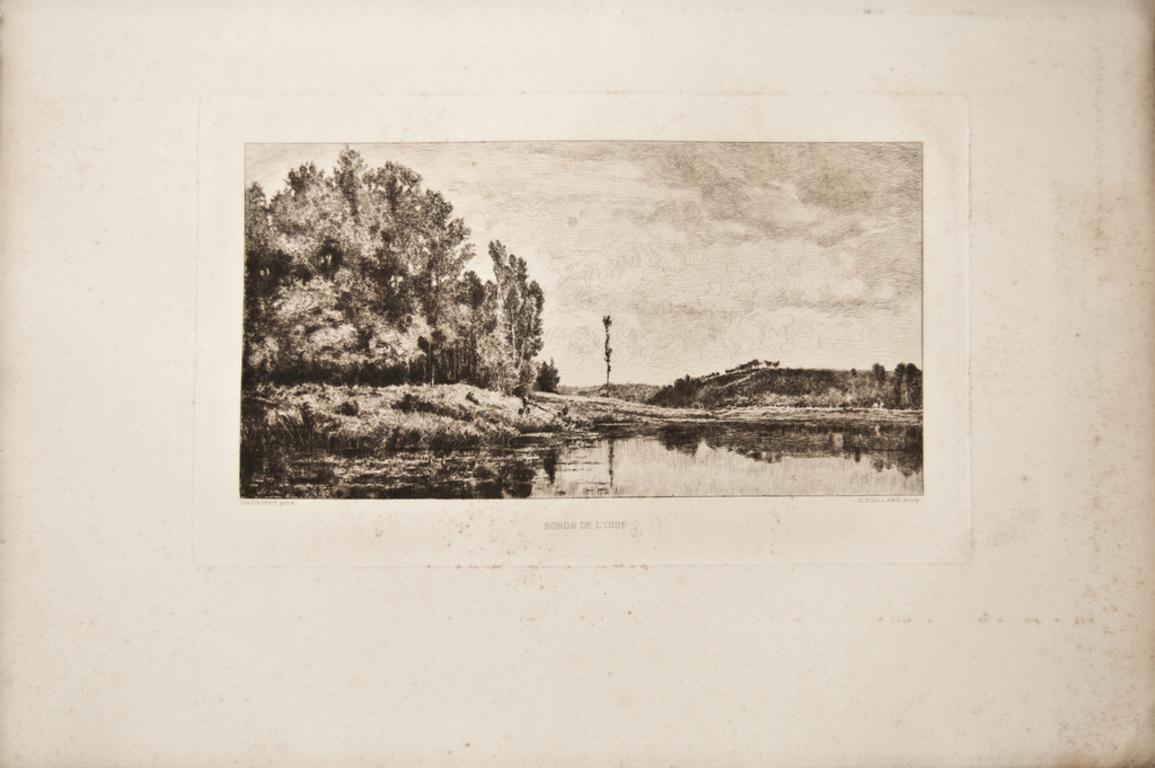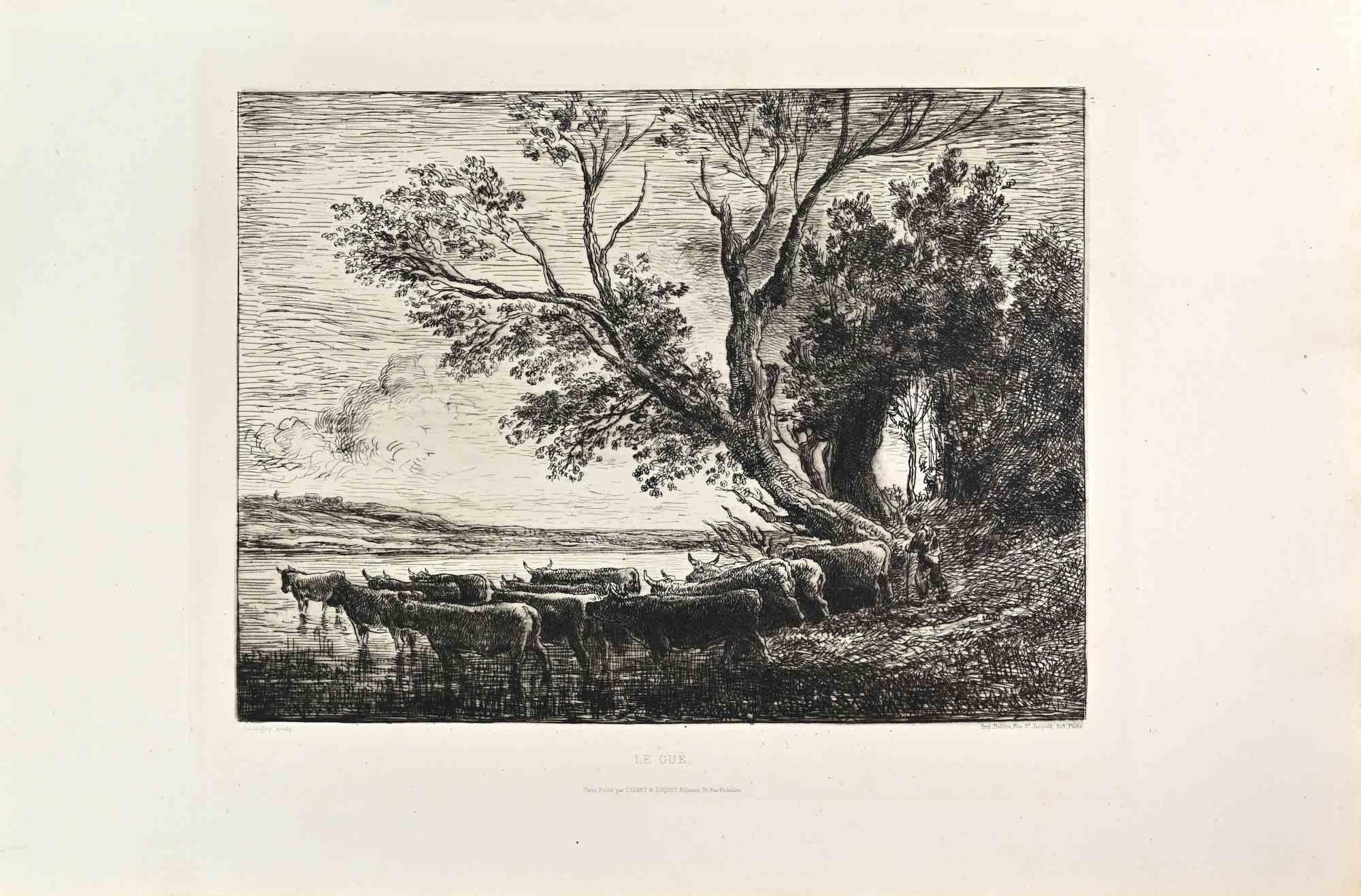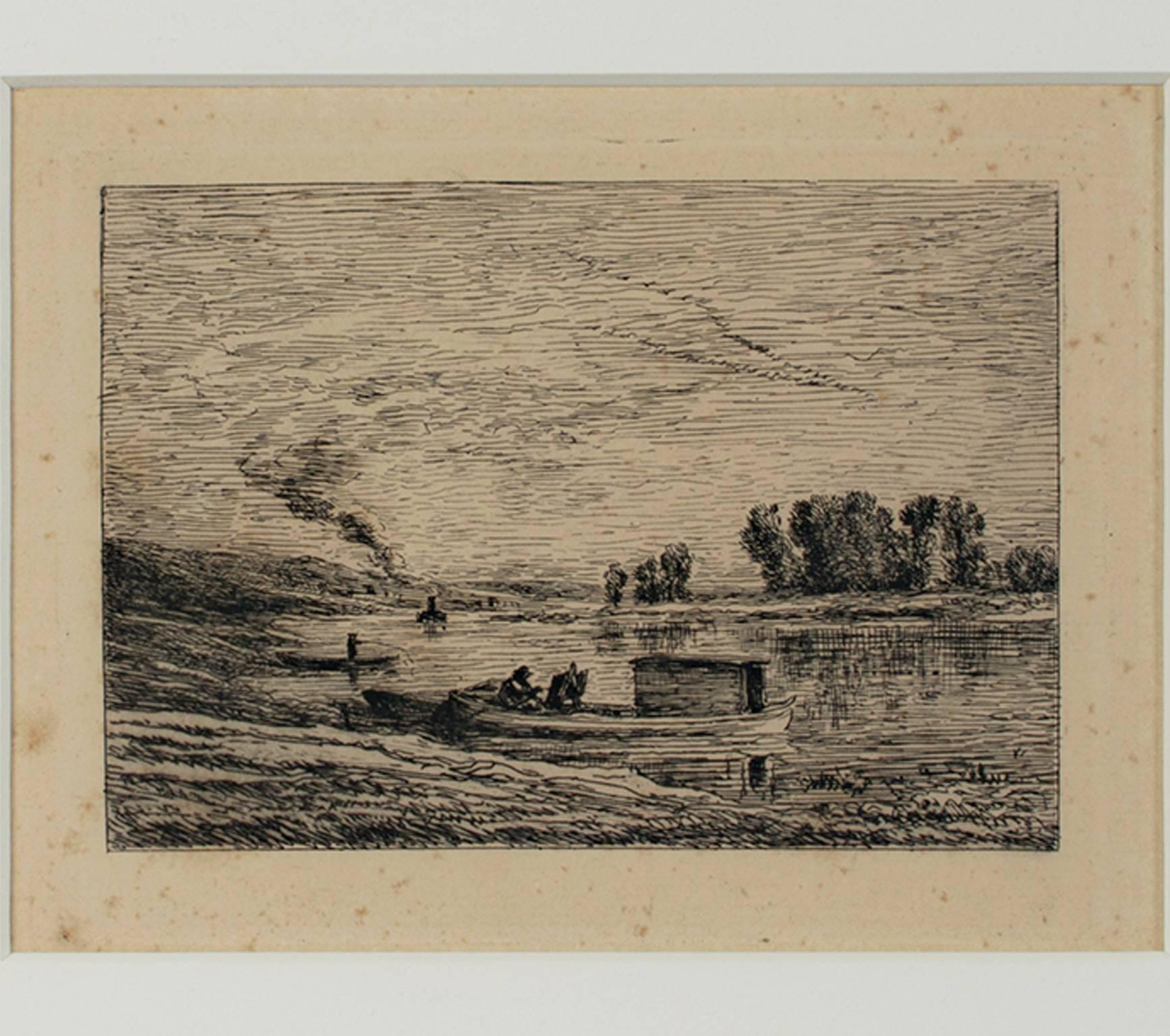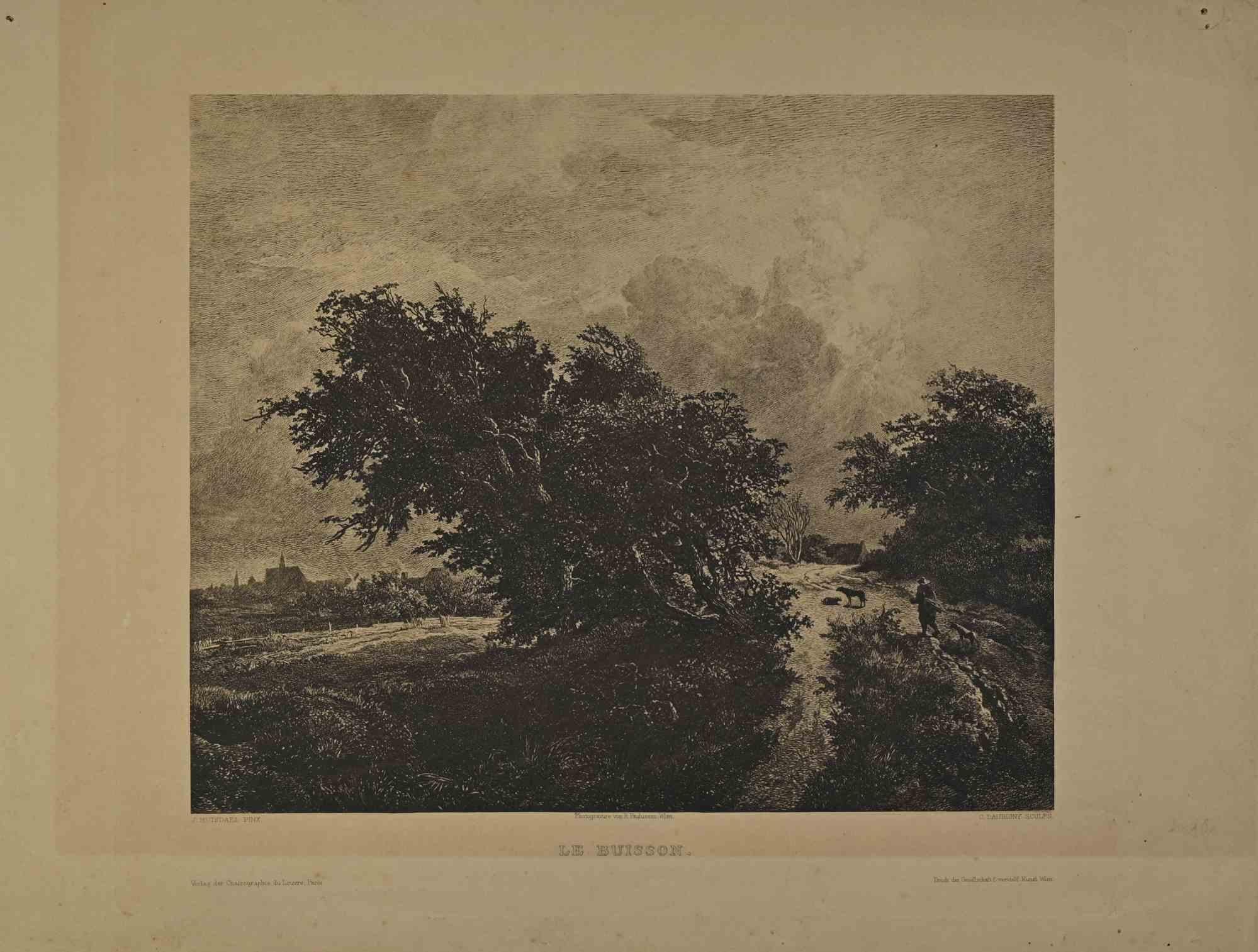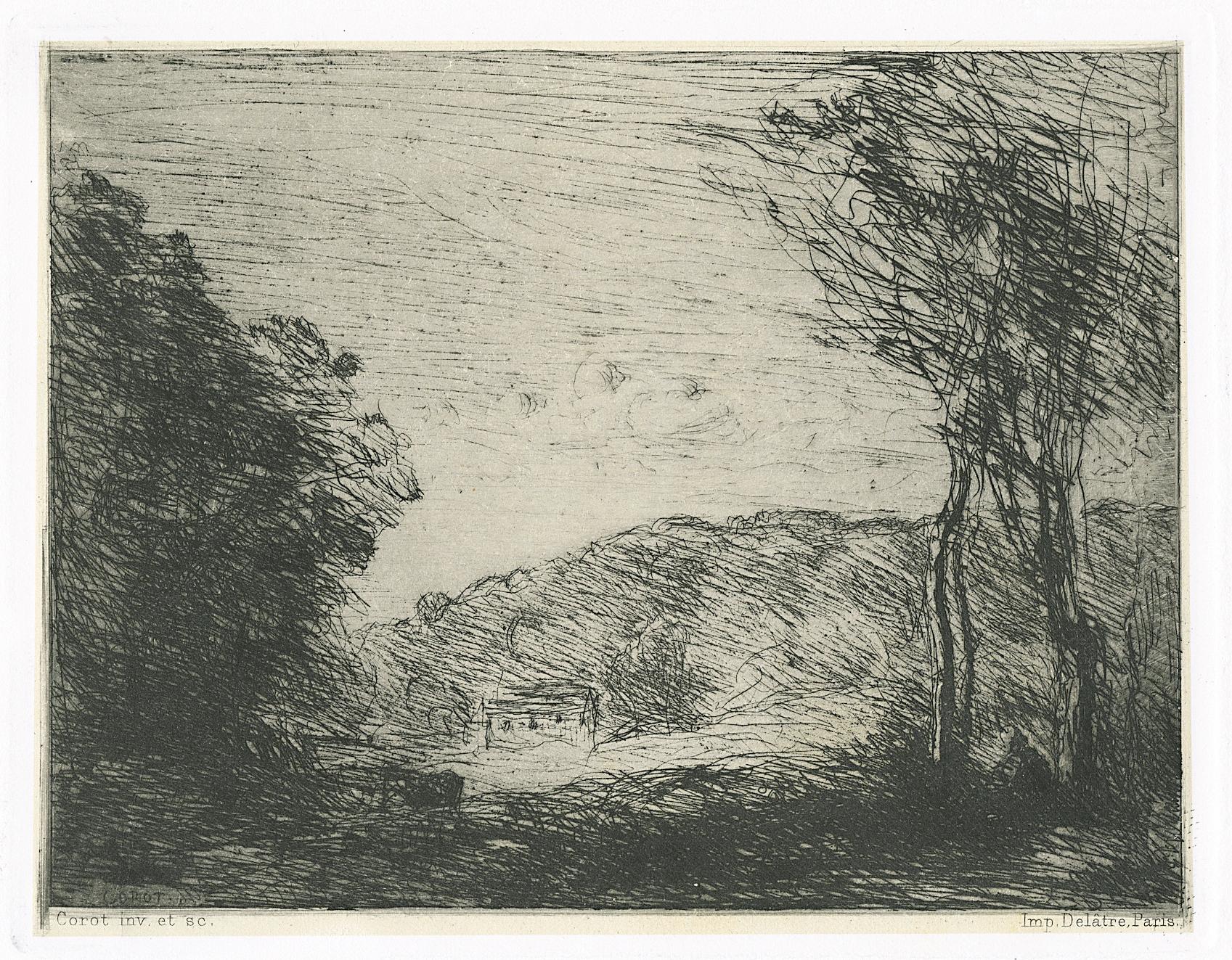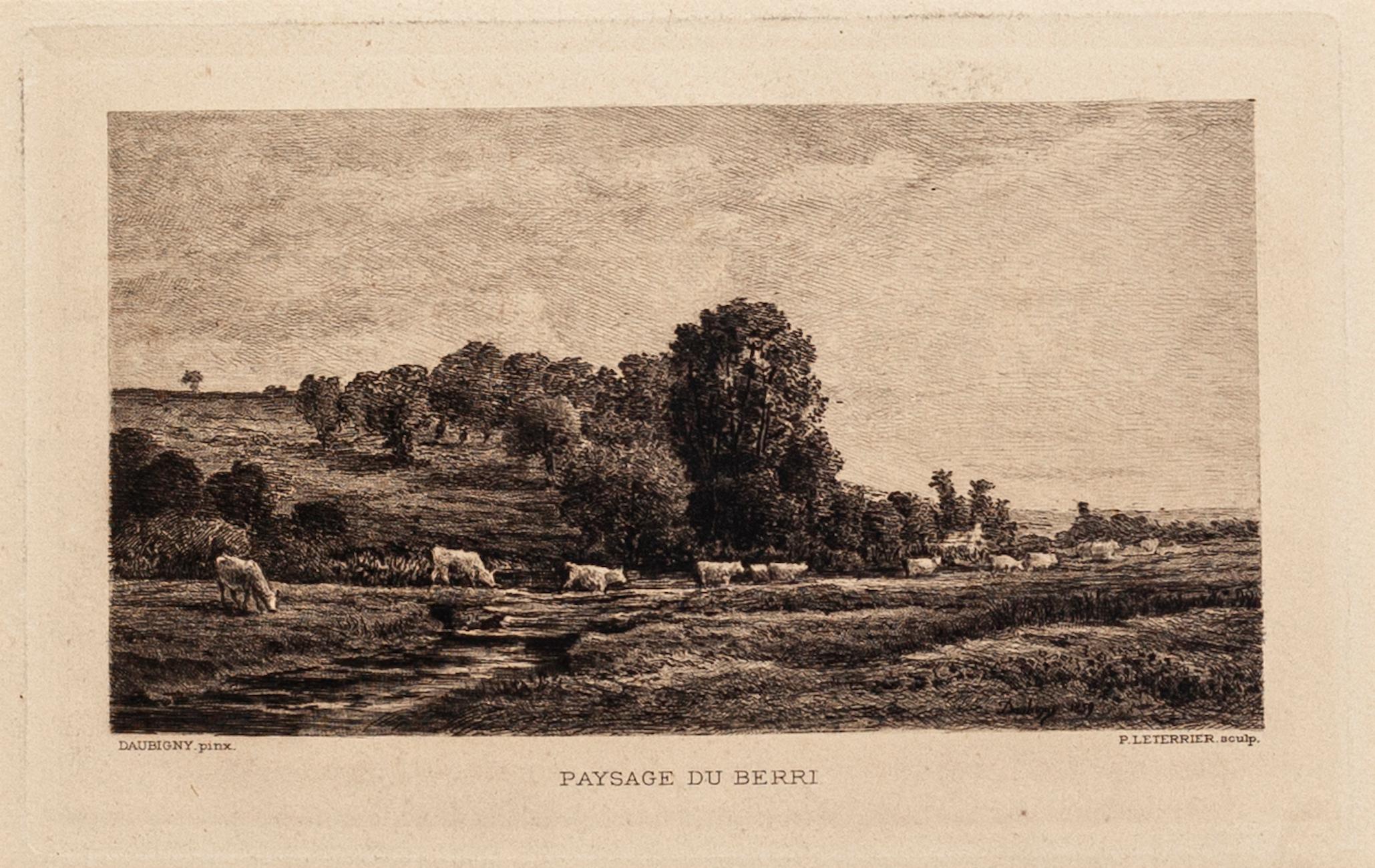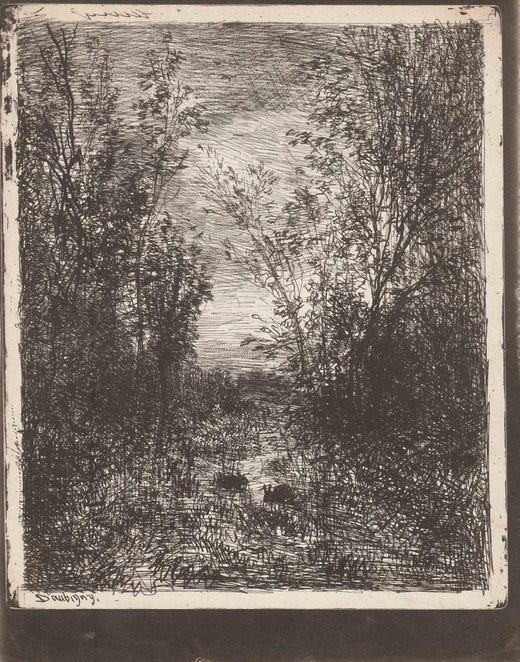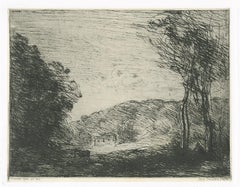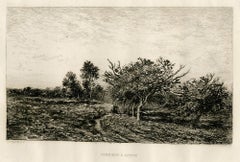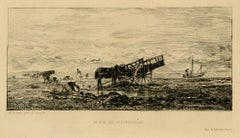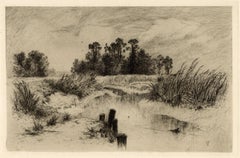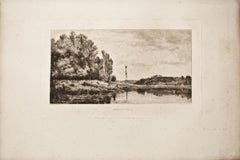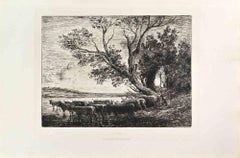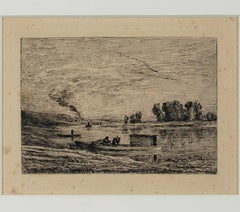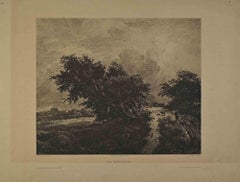Items Similar to Le Ruisseau Dans La Clairière (The Brook in the Clearing)
Want more images or videos?
Request additional images or videos from the seller
1 of 2
Charles François DaubignyLe Ruisseau Dans La Clairière (The Brook in the Clearing)1862
1862
$1,500
£1,132.74
€1,296.88
CA$2,118.39
A$2,312.78
CHF 1,212.49
MX$28,089.57
NOK 15,142.08
SEK 14,298.16
DKK 9,679.85
About the Item
Paris: 1862. Cliché-verre on lightweight photosensitive wove paper, 8 3/4 x 7 1/8 inches (220 x 180 mm) (sheet), full margins. Signed in the plate, lower right. Because this impression is printed on lightweight photosensitive paper, lacks a cancellation mark, and does not have 20th century publisher's seal; our opinion is that this is a lifetime impression. [Deltiel 137]
Daubigny was one of the first artists to explore the qualities of changing daylight and the effect it had on natural landscapes. In 1842 he began to travel frequently, and spent time in the woods of Fontainebleau and later in Burgundy, where he befriended Jean-Baptiste-Camille Corot. The two painted together in Switzerland and the Dauphiné. In 1857, Daubigny purchased a boat on which he built a floating studio. His mobile studio on the water gave him enormous freedom to select the optimal viewpoints for rendering landscapes in relation to shifting light, and he spent hours upon hours exploring the delights of the Oise, the Marne, and the Seine rivers.
In 1859 Daubigny received the Legion of Honor, and a year later he built a home and studio in Auvers. It was here that he focused on printmaking as a medium, largely in response to emerging criticism that his painted canvasses had become sketchy and dark. He found that etching fulfilled his stylistic inclinations, and he participated in an exhibition funded by the print publishing house Cadart in 1862. Subsequently Cadart became Daubigny's exclusive print publisher. Daubigny and his Barbizon School colleagues Corot, Rousseau, and Millet, had the opportunity to experiment with the completely new photographic reproductive process of cliché-verre. The Brook in the Clearing is an early example of one of these works.
The process of creating a cliché-verre combines painting, printmaking and photography. The image is brushed onto a glass plate with ink, then rubbed and burnished away in desired areas, forming the final composition. The glass plate is placed on photosensitive paper in a dark room, it's then exposed to daylight with the glass plate essentially acting as a photographic negative, and the image emerging through luminosity. Daubigny continued to explore the effects of light as he evolved the methods of its expression in his compositions. Unlike Corot, Rousseau, and Millet, it is thought that Daubigny did the lion's share of the printing of his cliché-verres himself. It's very likely Daubigny held this particular work in his hands.
- Creator:Charles François Daubigny (1817 - 1878, French)
- Creation Year:1862
- Dimensions:Height: 8.75 in (22.23 cm)Width: 7.125 in (18.1 cm)
- Medium:
- Movement & Style:
- Period:
- Condition:
- Gallery Location:Middletown, NY
- Reference Number:Seller: BH5951stDibs: LU1979210426622
Charles François Daubigny
Charles-François Daubigny, (15 February 1817 – 19 February 1878), Daubigny was born in Paris, into a family of painters and was taught the art by his father Edmond François Daubigny and his uncle, miniaturist Pierre Daubigny. Initially Daubigny painted in a traditional style, but this changed after 1843 when he settled in Barbizon to work outside in nature. Even more important was his meeting with Camille Corot in 1852 in Optevoz (Isère). On his famous boat Botin, which he had turned into a studio, he painted along the Seine and Oise, often in the region around Auvers. From 1852 onward he came under the influence of Gustave Courbet. In London he met Claude Monet, and together they left for the Netherlands. Back in Auvers, he met Paul Cézanne, another important Impressionist. It is assumed that these younger painters were influenced by Daubigny. Daubigny's finest pictures were painted between 1864 and 1874, and these for the most part consist of carefully completed landscapes with trees, river and a few ducks. It has been said that when Daubigny liked his pictures he added another duck or two, so that the number of ducks often indicates greater or less artistic quality in his pictures. He was named by the French government as an Officer of the Legion of Honor. Daubigny died in Paris in 1878.
About the Seller
5.0
Vetted Professional Seller
Every seller passes strict standards for authenticity and reliability
Established in 2004
1stDibs seller since 2022
74 sales on 1stDibs
Typical response time: 7 hours
- ShippingRetrieving quote...Shipping from: Middletown, NY
- Return Policy
Authenticity Guarantee
In the unlikely event there’s an issue with an item’s authenticity, contact us within 1 year for a full refund. DetailsMoney-Back Guarantee
If your item is not as described, is damaged in transit, or does not arrive, contact us within 7 days for a full refund. Details24-Hour Cancellation
You have a 24-hour grace period in which to reconsider your purchase, with no questions asked.Vetted Professional Sellers
Our world-class sellers must adhere to strict standards for service and quality, maintaining the integrity of our listings.Price-Match Guarantee
If you find that a seller listed the same item for a lower price elsewhere, we’ll match it.Trusted Global Delivery
Our best-in-class carrier network provides specialized shipping options worldwide, including custom delivery.More From This Seller
View AllCampagne boisée (Wooded countryside)
By Jean-Baptiste-Camille Corot
Located in Middletown, NY
1866
Etching on cream wove paper. 5 1/2 x 4 3/8 inches (138 x 110 mm), full margins. Third state (of 4). Light scattered age tone, and time stain. Scattered extremely light areas of ...
Category
Mid-19th Century Barbizon School Landscape Prints
Materials
Etching
Pommiers à Auvers
By Charles François Daubigny
Located in Middletown, NY
New York: Dodd, Mead, 1884.
Etching with aquatint on cream laid paper, 7 3/4 x 10 3/4 inches (196 x 272 mm), full margins. Light age tone, some very minor cockeling and a 1.5 inch v...
Category
Late 19th Century French School Landscape Prints
Materials
Laid Paper, Engraving, Aquatint
Plage de Villerville
By Charles François Daubigny
Located in Middletown, NY
Paris: Gazette des Beaux-Arts, 1856.
Drypoint etching on cream laid paper, 4 7/8 x 8 3/8 inches (124 x 245 mm), full margins. In good condition with light uniform age tone. Fourth s...
Category
Mid-19th Century Realist Landscape Prints
Materials
Drypoint, Etching
Passaic Meadows (In the Newark Meadows)
By Thomas Moran
Located in Middletown, NY
Boston: American Art Review, 1880. Etching on cream laid paper, 5 3/4 x 8 3/4 inches (146 x 230mm), full margins. Light uniform age tone, scattered handling creases and minor toning ...
Category
Late 19th Century Realist Landscape Prints
Materials
Laid Paper, Etching
Environs de Rix (Ain)
By Adolphe APPIAN
Located in Middletown, NY
Paris: Cadart, 1865.
Etching on buff wove paper, 3 1/2 x 7 inches (88 x 177 mm), full margins. In good condition with some light toning and several minor spots of light discoloratio...
Category
Mid-19th Century French School Landscape Prints
Materials
Etching
Bords d'une rivière avec deux bateaux (River banks with two boats)
By Charles-Emile Jacque
Located in Middletown, NY
Etching on chine collé mounted to white wove paper, 3 11/16 x 5 (92 x 125 mm), full margins. In good condition with minor mat tone. Printed by Delâtre, Paris.
[Guiffrey 34]
Category
Mid-19th Century French School Landscape Prints
Materials
Etching, Handmade Paper
You May Also Like
Bords de L'Oise - Etching by Charles-François Daubigny - Late 19th Century
Located in Roma, IT
Signed and titled on plate. Etching and aquatint print. Good condition.
Category
Late 19th Century Surrealist Figurative Prints
Materials
Etching
Le Gue - Etching by Charles François Daubigny - 1860s
By Charles François Daubigny
Located in Roma, IT
Le Gue is a black and White etching realized by Charles François Daubigny in the 1860s.
Titled in the lower.
Image size: 30x37.
Very good impression with wide margins and a very ...
Category
1860s Modern Figurative Prints
Materials
Etching
19th century black and white etching industrial landscape boat riverbank trees
By Charles François Daubigny
Located in Milwaukee, WI
"Le Bateau a Conflans/Le Paysagiste au Bateau" or "The Boat at Conflans/Landscape with Boat" is an original etching by Charles Francois Daubigny...
Category
Late 19th Century Barbizon School Landscape Prints
Materials
Etching
Le Buisson - Etching by C.F. Daubigny - 19th Century
Located in Roma, IT
Le Buisson is a photogravure realized in the 19th Century.
signed.
Good condition.
Category
19th Century Figurative Prints
Materials
Drypoint, Etching
Paysage du Berri - Etching by Charles-François Daubigny - 19th Century
Located in Roma, IT
Paysage du Berri is an original black and white etching on paper, realized by Charles-François Daubigny.
At the bottom left margin the printed inscription: "DAUBIGNY" pinx; bottom c...
Category
19th Century Barbizon School Figurative Prints
Materials
Etching
Bords de l'Oise, France - Original Etching by Maillard After Daubigny - 1860 ca.
By Charles François Daubigny
Located in Roma, IT
Image dimensions: 17.5 x 28 cm.
Signed on plate. Includes passepartout.
Very good conditions.
Category
1960s Barbizon School Figurative Prints
Materials
Etching
More Ways To Browse
Ashley Andrew
Auguste Delatre
Buckels Jim
Camel Caravan
Ernest David Roth
Industrial Etchings
John Le Keux
Normandie Poster
Phil Greenwood Limited Edition Etching
Prince Of Wales Signed
Vintage Aviation Memorabilia
Virgil Thrasher
Antique Maps Cambridge
Chamonix Poster
Christo Fabric
Colorado Ski Poster
Desert Plein Air
Earl Of Sandwich
